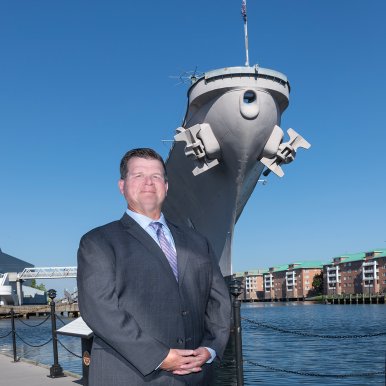Gazing into the future
What does 2043 have in store for Hampton Roads?

Illustration by Tom Edwards

Illustration by Tom Edwards
Gazing into the future
What does 2043 have in store for Hampton Roads?
The waterways and shorelines that make up Hampton Roads harbor a historic reputation as ideal hosts for commerce, trade, shipbuilding, military installations and government research. Its beaches and historical sites attract millions of visitors, and the region is home to farms, businesses and universities.
We know the past and present, but what about the future of Hampton Roads? We asked several regional leaders to give us their view for what the future has in store for the area 20 years from now. They offered predictions about the region’s workforce, business opportunities, transportation, federal defense spending and other economic influences.
Home to more than 1.7 million people, Hampton Roads includes 10 cities and six counties in southeastern Virginia and nearly 3,000 square miles of diverse landscape, as noted in the 2022-2027 Comprehensive Economic Development Strategy (CEDS) for Hampton Roads. “It is well-known that in Hampton Roads, the three pillars of the regional economy are the port, the military and tourism,” it reads.

Developed by the Hampton Roads Planning District Commission in partnership with the Hampton Roads Alliance and Old Dominion University, the report was approved by the U.S. Economic Development Administration in 2022. Authored primarily by planning district commission members Greg Grootendorst, Katherine Rainone and Katie Cullipher, it also contains valuable insights from Robert McNab and Tim Komarek of ODU’s Dragas Center for Economic Analysis and Policy, along with other members of its strategy committee.
Essentially, this report provides a glimpse into what Hampton Roads was, is and hopes to be. Among the region’s strengths are its demographic diversity, higher education institutions, competitive business costs and a strong federal workforce — but its weaknesses include dependence on federal spending, a lack of private-sector job growth, not enough affordable housing and regional fragmentation, according to the CEDS report.
“If you look at Hampton Roads,” explains McNab, “it is a distinctive place in terms of its role in the national security of the United States. It has had this distinctive role for over two centuries. That is a blessing, but some might call it a curse.
“It is a blessing because, for over 200 years, Hampton Roads has been one of the focal points of the United States Navy and the Armed Forces on a broader scale, and the federal government,” he says. “This distinctive role is unlikely to diminish significantly in the near term, especially with advances in technology, specifically unmanned systems, artificial intelligence and the revolution in military affairs that now we’re seeing another iteration of in Ukraine with regards to the performance of large-scale, very expensive weapon systems relative to inexpensive, unmanned drones.”
In the short term, McNab adds, “the prospects for defense spending and federal government spending in the region are quite favorable. One might argue that we’ll continue to see increases in defense spending over the next three to five years nationally and within the region.”
Hampton Roads Workforce Council President and CEO Shawn Avery says he believes that Hampton Roads’ short-term economic future looks promising for myriad reasons, including the expansion of the Hampton Roads Bridge-Tunnel (HRBT), the largest highway construction project in the Virginia Department of Transportation’s history.
The $3.9 billion bridge and tunnel expansion will add twin tunnels and will double the number of lanes to eight along 10 miles of Interstate 64. Its original deadline was the end of 2025, but workers are about a year behind schedule, so that deadline’s likely to change.
Aside from easing local traffic gridlock, “the HRBT expansion will open more economic collaboration and growth with the RVA corridor,” says Avery. “The region’s continued expansion into autonomous systems will situate us as one of the only regions in the nation able to develop and test related technology for land, sea, air and space.
“And our maritime industry will continue to expand as we become the offshore wind hub for the East Coast and pursue the Navy’s mission to build and repair the most advanced ships and submarines in the world.”
On the tourism front, “the Hampton Roads region [and] Williamsburg will be an area of national focus in 2026, for our country’s 250th anniversary, leading up to July 4, 2026,” points out Nancy L. Grden, Hampton Roads Executive Roundtable president and CEO. “What a great opportunity to celebrate and communicate our region’s unique brand, and to create ‘new history.’ By that time, we will have exciting growth and expansion initiatives coming to fruition for the future — and unlike any other region in the country.”

Special attributes
Looking beyond the immediate future, experts laud the region’s noteworthy qualities that make it stand out both in Virginia and nationally.
“Amongst large metropolitan areas with more than 1 million people, we have the largest proportion of our economy that is derived from federal government spending and specifically defense spending, apart from the Washington, D.C., metro area,” McNab notes.
“The challenge really … over the next five to 20 years remains the challenge that has been present in front of the region over the last two or three decades,” he adds. “That is, how do you diversify the economic base of Hampton Roads, such that we continue to occupy the distinctive role of national security of the United States but have other pillars of the regional economy that generate well-paying jobs and economic activity that are not dependent upon decisions in Washington, D.C.?”
Options vary, but Douglas L. Smith, president and CEO of the Hampton Roads Alliance, sees promise in the air — literally.
“Hampton Roads is quickly becoming a center of excellence for air mobility and unmanned systems,” Smith says. He anticipates that, through the research and development underway at NASA Langley and at various military installations, Hampton Roads will pioneer cutting-edge aerial transportation powered by carbon-free alternative fuels, pushing the boundaries of what’s possible in the skies.
“We believe there is room to grow the defense sector in Hampton Roads by leveraging assets needed by businesses that directly support military installations and major defense contractors in the region,” Smith adds. “The world is increasingly looking at Hampton Roads because of our competencies in these sectors and the natural competitive advantages of our business environment. Virginia is a global brand as a perennial ‘best state to do business.’”
McNab says that transportation expansion is also key to the region’s economic health.
“The state and federal government need to agree to punch through I-87 into North Carolina to create a more robust transportation system to the southwest,” he notes. “If you look at Hampton Roads, it’s often colloquially referred to as the world’s largest cul-de-sac because we don’t have real significant transportation outlets to the south and the west. Getting that interstate highway down to Raleigh and connecting into Charlotte will create a corridor where not only manufactured goods can come out of the port and go to other areas, but an area where we can re-manufacture goods and re-export them — and that’s where real value is.”
Avery points out that the years ahead will also present some challenges and opportunities for Hampton Roads, particularly given its large military footprint and its risk from sea-level rise.
“Coastal resiliency will continue to be key concerns for Joint Base Langley-Eustis, as well as Naval Station Norfolk,” he predicts. “The continuing need to upgrade the Navy’s aging fleet and the increase in demand for newer vessels will be a priority for our national security. Newport News Shipbuilding, Norfolk Naval Shipyard and the membership of the Virginia Ship Repair Association will be critical role players in this effort.”
Paul Robinson, executive director of RISE, a Norfolk-based nonprofit that helps resilience-focused businesses grow, points out that coastal communities nationwide face the accelerated impacts of climate change, and nearly half of the U.S. population reside in these vulnerable areas. Flooding related to sea-level rise and other factors place homes, businesses and even military installations at risk.
“These hazards pose a significant risk to approximately $1 trillion worth of real estate and infrastructure along U.S. shores, and the global cost of coastal flooding events could reach $14.2 trillion by the end of the century,” Robinson says. “The Norfolk-Virginia Beach metropolitan area alone currently ranks 10th in the world in the value of assets exposed to an increase in flooding from sea-level rise.
“Adapting to these challenges is crucial to reduce damage and enhance long-term sustainability,” Robinson adds. “Climate adaptation requires a holistic, long-term perspective that involves investing in infrastructure that can protect vulnerabilities well into the future, along with innovative and affordable solutions to reduce risks now.”
Workforce predictions
While global warming and sea-level rise are of major concern in the Hampton Roads region, experts note that there are also microcosmic influences that can affect the future.

Looking at the workplace, McNab predicts, “Growth in Hampton Roads will probably occur in small to midsize firms. And if we create an environment where entrepreneurship and innovation are supported and successful by investments in our infrastructure, including broadband and transportation, then we are creating jobs that also retain talent.
“If we look 5, 10, 15 years down the road, we also need to recognize that, if we have a workforce that is increasingly suffering from health or mental health issues, we could do everything right and there just won’t be enough workers to fill the jobs out there. This will be a longer-term challenge, not only for Hampton Roads but for Virginia and the United States as well,” McNab adds.
Emerging industries that will shape the region over the next two decades, Avery says, will include offshore wind, advanced manufacturing and IT.
“More than a dozen offshore wind projects are in advanced stages of planning on the East Coast of the United States,” he notes. “The federal government has set a national goal to produce 30,000 megawatts of energy by 2030. With development of Dominion Energy’s Coastal Virginia Offshore Wind project and Avangrid Renewables’ Kitty Hawk Offshore Wind project, Hampton Roads is now on a trajectory to lead offshore wind development in the U.S.”
Also, Avery says, “the Hampton Roads region is ripe for the advanced manufacturing industry, based on the region’s multimodal network, the workforce, innovative technology, and its location for rapid distribution from the Port of Virginia. In addition, information technology, specifically fiber optics, is an emerging industry in our region.”
International investment, too, will factor into the region’s future prosperity, Smith adds. “Global competition for foreign direct investment is increasing at a record pace. Within the commonwealth, the Global Business Alliance estimates that 6.3% of Virginia jobs are tied to foreign direct investment, and employees at international firms earn roughly 10% more than the national average wage.”
And at an even more nitty-gritty level, Hampton Roads has a notable startup community that has grown significantly over the past five years, Grden says. “The past five years have laid a foundation,” with players in the local entrepreneurial ecosystem including the innovation centers at ODU and Norfolk State University, 757 Collab and Black BRAND.
“The region will be able to create bridges between this entrepreneurial ecosystem and our economic development partners to scale up more companies in key industry clusters relevant to our region,” she says. “It is also fortunate to have major federal facilities and sources of innovation, such as Jefferson Lab, NASA Langley Research Center and others, which should result in intellectual property converting into commercialization and new company/talent attraction.”
-
















